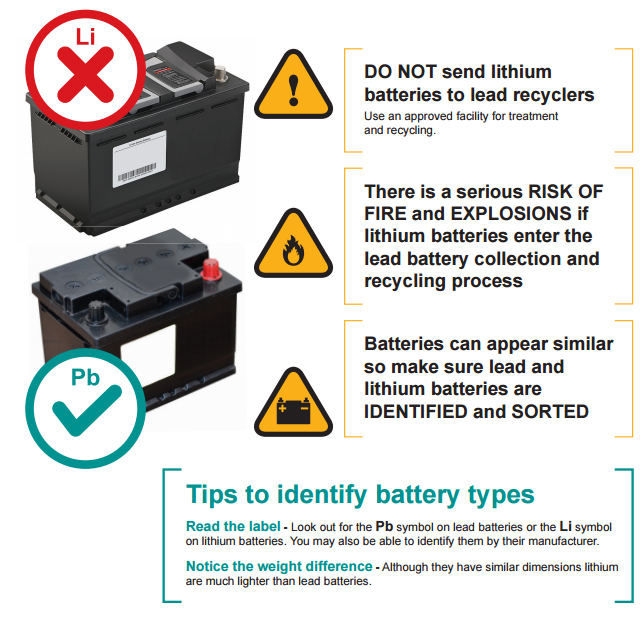The U.S. Society of Automotive Engineers (SAE) and the International Electrotechnical Committee (IEC) are proposing to develop standardized labels that are color-coded to allow for better identification between lead-acid and lithium-ion batteries.
Lead Recycling Threatened By Lithium-ion
Contributed by | Battery Council International
Concerns over Lithium-ion contaminating the near perfect record of lead battery recycling
New information distributed by the Battery Council International, a not-for-profit trade association of more than 200 member companies worldwide, and battery manufacturers such as U.S. Battery Manufacturing, warn about the introduction of Lithium ion batteries entering the lead battery collection and recycling process.

Industry studies show that lead-acid batteries are recycled at the highest rate of any commercial product - a rate of 97 to 99 percent. With the increase of lithium-ion battery use, the introduction of these batteries into the lead recycling system has resulted in a number of safety incidents as reported by the International Lead Association, ILA.
The BCI warns he risks of fires and explosions can occur during transport, storage, battery breaking and smelting processes of used lead-based batteries, if lithium-ion batteries are mistakenly or knowingly added into the recycling process. Since both types of batteries look similar, proper identification is required when recycling plants receive pallets or bins containing used batteries.
To properly inform recyclers manufacturers such as U.S. Battery, along with lead recycling and battery industries of North America and Europe, the International Lead Association (ILA), the industrial and automotive battery manufacturing and recycling associations of Battery Council International (BCI) and Europe (EUROBAT), and the Association of Battery Recyclers (ABR), have created a joint initiative to warn about lithium battery contamination. These organizations urge battery collectors to:
- Look for the proper labeling - Battery labels contain a Pb symbol on lead batteries and a Li symbol on lithium batteries. It may also be possible to distinguish the chemistries by their manufacturer.
- Notice the weight difference - Although they have similar dimensions lithium batteries are much lighter than lead batteries.
"The lead battery industry has the most successful recycling program in the world," says Mark Thorsby, Executive Vice President of BCI. "In no way do we want to jeopardize our success or compromise our commitment to sustainability. Preventing lithium-ion batteries from entering the lead battery recycling process is critical to achieving that outcome."
While it's important to carefully read the battery labels before collecting or sending batteries to a lead recycling plant, another solution is now being developed. The U.S. Society of Automotive Engineers (SAE) and the International Electrotechnical Committee (IEC) are proposing to develop standardized labels that are color-coded to allow for better identification between lead-acid and lithium-ion batteries.
For more information on properly identifying flooded lead-acid batteries and lithium-ion batteries, contact the Battery Council International at www.batterycouncil.org. Or contact U.S. Battery Manufacturing at 1675 Sampson Ave. Corona, CA 92879. (800) 695-0945. Visit http://www.usbattery.com.
The content & opinions in this article are the author’s and do not necessarily represent the views of AltEnergyMag
Comments (0)
This post does not have any comments. Be the first to leave a comment below.
